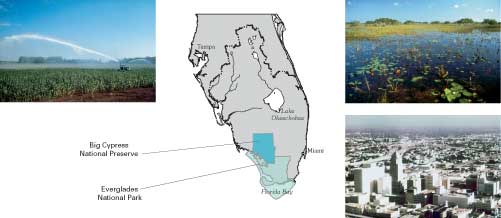A
Quantity and Quality of Water Define Availability: An Example from South Florida
Historically, availability of water could be viewed simply as an issue of quantity, and water management could focus largely on controlling or alleviating impacts of droughts and floods. With escalating population growth and increasing demands for multiple water uses, it is now clear that quality is equally critical to the long-term sustainability of the Nation’s human communities and ecosystems.
Resolution of water issues at the local and regional scale commonly requires a framework that links both the quantity and quality needs. This framework is perhaps nowhere more evident than for the water-rich South Florida region with its competing uses of water for agriculture, urban growth, and natural-resource protection. An abundant and uncontaminated supply of freshwater was a primary characteristic of southern Florida in predevelopment times. Increased human population and activity, however, have brought not only an increased need for water but also a decrease in water supply and deterioration in water quality (McPherson and Halley, 1996; McPherson and others, 2000).
Before the construction of more than 1,400 miles of primary canals and more than 100 water-control structures, water moved from Lake Okeechobee in a large sheet passing through the Everglades National Park and Big Cypress National Preserve into Florida Bay. Numerous small streams and rivers near the coast drained into mangrove forests and tidal waters and provided the freshwater that sustained the highly productive and abundant coastal fisheries around the southern end of the peninsula.
Approximately 40 percent of that water is now diverted, much of which is used to support heavily irrigated agriculture and urban development along the coast. Such drainage and development have adversely affected water quality and ecology throughout southern Florida. For example, average phosphorus concentrations in Lake Okeechobee have increased two and one-half times over the past 15 years, and massive algal blooms have become more frequent and persistent. In addition, urban uses of water have affected water quality. Stormwater runoff commonly carries heavy metals, nutrients, bacteria, viruses, and pesticides.
Many integrated and collaborative efforts are ongoing to study the Everglades and address some of these conflicting needs for water. For example, recent decisions have been made to set land aside south of the agricultural area to help remove nutrients before the water moves farther southward. Additionally, water is being recycled from agricultural lands back to the fields, instead of moving south toward Florida Bay, thus holding back nutrients and reducing water demand. Water conservation in the urban areas may well stabilize, or even decrease, the population demands for water. Water issues in South Florida demonstrate that water availability challenges every region of the Nation where sufficient quantity and quality of water are needed to sustain the many competing demands for the resource.
 |
|
Figure A–1. Competition for water to meet the needs of cities, farms, industries, and critical ecosystems challenges every region of the Nation, including south Florida where urbanization and agricultural activities have altered the hydrologic environment. Left, irrigation of crops in southern Everglades C–111 agricultural basin; upper right, northern Everglades; lower right, aerial view of Miami. Photographs by Benjamin F. McPherson. |
